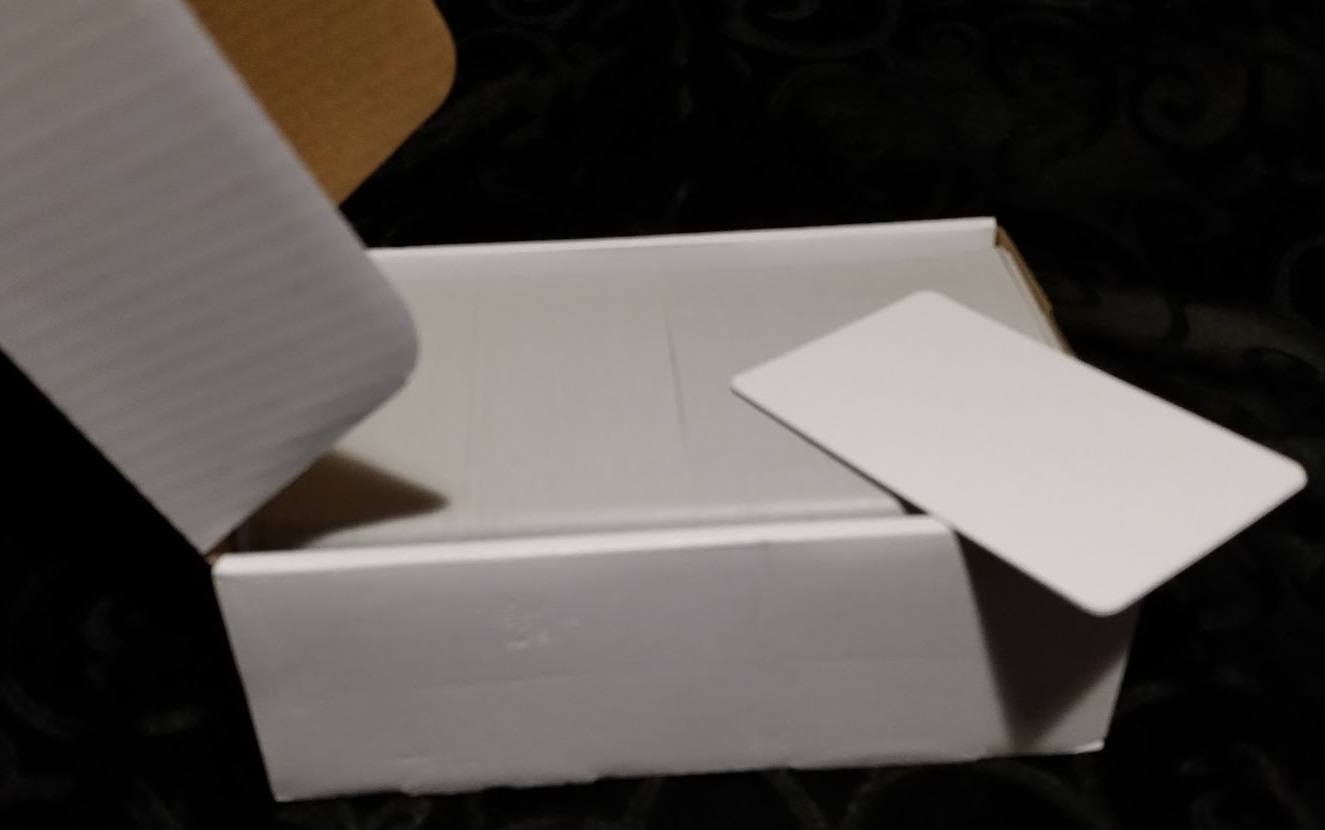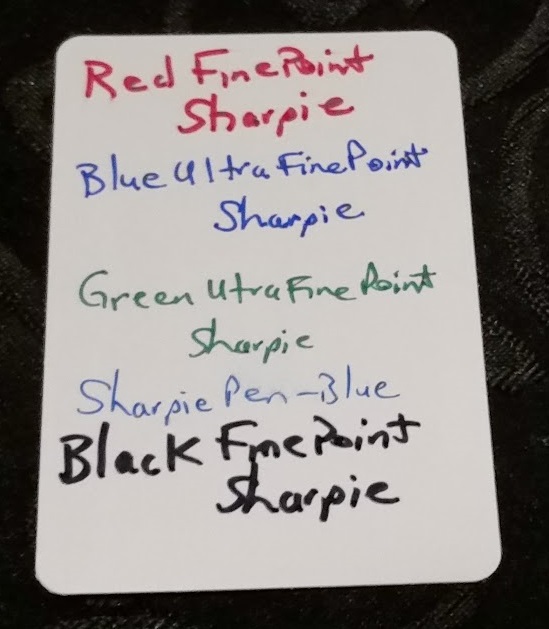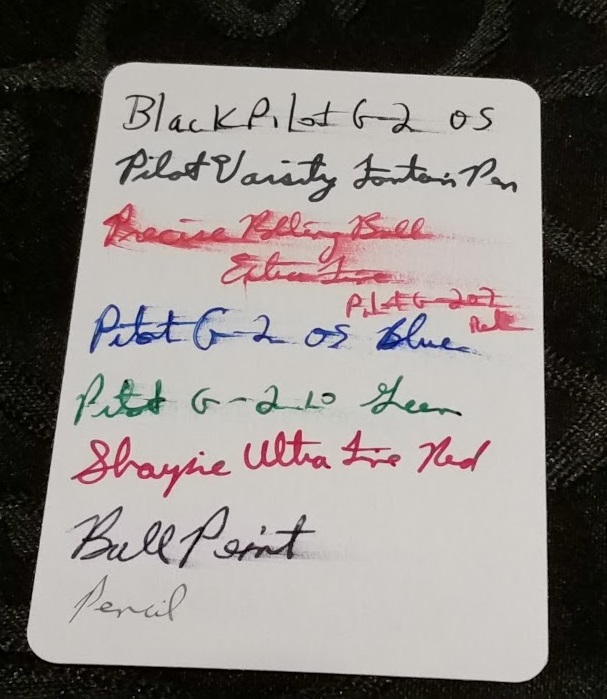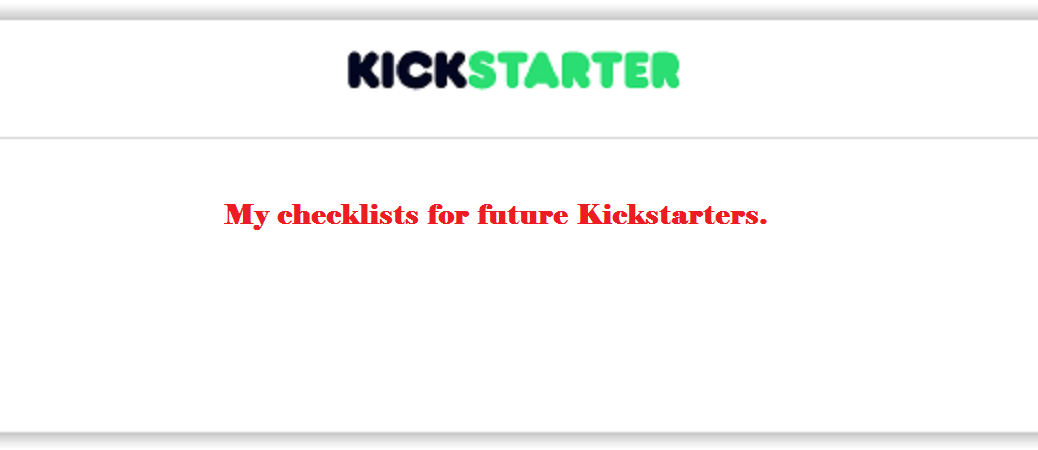I shared a couple of days ago that while at Gary Con IX, I woke up with an idea for a card game that could be good enough to Kickstart. On the drive home, I had an idea for another card game that I think is also good enough to Kickstart. The second one is simpler, and thus I think a better option for a first Kickstarter.
I’ve made a checklist and a price list to determine break even points, i.e the minimum amount for a Kickstarter. I don’t have all the numbers, but it shows how little one actually makes unless the thing goes viral. One should do this for the love of creating and playing games, and not count on it for a living.
I’m interested on feedback on this list. I don’t have all the answers for some points, but I want to make sure that I avoid pitfalls. I have a few specific questions at the end under Input.
Preparation Checklist
Independent of the financial considerations, there are a lot of things to keep in mind.
- Design, write, & play test the game.
- Get input from trusted friends who have lots of ideas about such things.
- Test what pens/inks/pencils will write on blank cards before making first play test deck.
- Copyright for parts that can be copyrighted.
- Trademark for the name of the game.
- LLC or similar for a company to separate my personal assets from it, just in case.
- NDA to share ideas with others, just in case.
- Custom URL & Website for game.
- Use DriveThru Cards for fulfillment, as they can print on demand and do individual shipping.
- For the Kickstarter itself, can do a bulk order delivered to my home and I do the shipping, within the U.S.
- Rules – They will need to be polished enough that your play testers understand. You also have to be flexible to revise and change through the course of play testing.
- Final rules will need to be proofread and edited for a polished presentation free of errors.
- Cards – For POD a PDF of the cards fronts & backs are needed. If you don’t have the skill to make such a PDF, you will either have to learn it or hire it done.
- Video – A video showing what it is with an example of play.
- High quality video is downgraded if placed in the spot Kickstarter gives you. Some place the video below that, linked from YouTube. They put a graphic in the spot Kickstarter offers for a video.
- Engagement – You will have to engage with backers during the entire run of the Kickstarter and push it on social media. If you don’t work it until the end of the run, it may not fund, or you will miss out on actually making money.
- Delivery timeline. It must be realistic and have padding for unexpected delays. Make sure that you can deliver no later than that date.
- Communicate with backers all the way through final fulfillment.
- People are suspiscious of those who launch a Kickstarter and have never backed any.
- You should back a few Kickstarters and see how they handle things, so you can see what you liked and didn’t about being on the backer side of things. This will be a good experience so you can avoid customer service pitfalls.
- Don’t run it too close to the end of the year, that you can’t spend money towards fulfillment, this will reduce the amount of taxes. My model with the $1,000 level shows the effects of waiting until the following year to pay expenses.
- Minimize changes from Kickstarter coments.
- Minimize or avoid stretch goals, and only use stretch goals that add value. Such as tuck boxes for card games, or GM screens for TTRPGs.
Cost Checklist
At some point, you will have to spend money, and will need to have very close estimates on costs so that your Kickstarter goal garners enough money to fulfill without finances being an issue. I don’t plan to spend much money on this until I have a play tested game that has the kinks worked out. If it isn’t a fun game and consulting with friends and play testing doesn’t change that, then I know not to sink a lot of time and money into it.
- If you can afford it, pay all the upfront costs before the Kickstarter so that it is ready to fulfill as soon as the funds are released.
- Work that Kickstarter every day that it runs to get the word out.
- Leading up to the Kickstarter let people know you are working on something to help build interest before launch.
- The quicker a Kickstarter hits the funding level for its goal, the more likely it is to go above and beyond and lead to making decent money.
- Make backers pay for shipping separately, so none of it comes out of the Kickstarter. That is a cost that can change unexpectedly and is one of the biggest reasons for failed and late Kickstarters. Second only to those that did not start any work until funding. Always do as much work as possible BEFORE launch.
- $15 for box of 500 blank playing cards from Amazon.
- $15-$20 for a domain name.
- If you don’t know how to do your own website, you will need to factor in costs and add it to the Kickstarter.
- If you do this all yourself, keep track of the hours to determine your final hourly rate.
- Assume a bare bones $1,000 Kickstarter & pre-existing art and no other costs.
- Taxes would be about 28.75%, based on being a self-employed effort, instead of the tax benefits of an LLC or similar.
- NOTE: Research how much the taxes are for this model.
- Kickstarter & Stripe fees would be 38.75%
- Total taxes and fees would be $380.50, leaving $619.50 to cover expenses.
- Taxes would be about 28.75%, based on being a self-employed effort, instead of the tax benefits of an LLC or similar.
- Low volume & High volume runs. Assume maximum deck size of 120 cards.
- The only way to decrease cost per card is to shop around for other fulfillment options. Most likely, these will require more effort to handle shipping, etc. So you will need to keep that in mind. How much work do you want to do to complete fulfillment to all backers?
- Low Volume is less than 5,000 cards at $0.085 each, or $10.20 for a 120 card deck. Plus $1.00 for a plastic deck box. This is $11.20 per deck.
- 50 decks would cost $560.00. (However, this would be enough cards for high volume printing, is delivered to same address.)
- The $619.50 left after taxes and fees is further reduced by the $560 for the decks, leaving a net profit of $59.50.
- High Volume is 5,000 cards or more at $0.06 each, or $7.20 per 120 card deck. Plus $1.00 for a plastic deck box. This is $8.20 per deck.
- 50 decks would cost $410.00
- You can only take advantage of this cost if all the decks are shipped to the same location. Add shipping to this location, how much?
- The $410.00 left after taxes and fees is further reduced by the $560 for the decks, leaving a net profit of $209.50.
- If shipped to your location, and you do all the hours of work involved, and your hourly rate will soon be negative.
- If you pay $1,000 for art, you will need to plan for more than $2,000 for the goal, or you will be in the red, due to taxes & fees.
- The only way to avoid paying for art is to use public domain art, or do it yourself.
- NOTE: How much for art for 50 cards, for example. Most of the rest would have the same image on them?
- This requires contacting multiple artists, seeing samples of their work, and working out rights to use their are, or purchasing copyright from them.
- Assume that they will not do the work until you have the money.
- If you pay $1,000 for lawyers, you need to plan for more than $3,000 for the goal. Always remember taxes & fees.
- Depending on where you live, this rate could be high, or way low.
- You will want to shop around for the best rate.
- Do research on what you want the lawyers to do for you and gather all the information in an organized fashion, so that they can just do the part of making the legal jargon valid.
- If you pay $1,000 for editing and layout, then you need to plan for over $4,000 for the goal. Again, there are still taxes & fees.
- Again, most work will not get done without you having the money.
- There may be other things you discover as you go that will drastically affect your estimates of costs if you find them AFTER you launch the Kickstarter.
- Contact others who have run Kickstarters similar to the one you have in mind to make sure you didn’t forget anything.
- Keep track of all the hours spent at each step from the initial idea to the fulfillment of the Kickstarter and use that to determine your hourly rate of pay base on how much money is left.
- As should be evident, it is very difficult to get rich or make a lot of money with Kickstarters if you are honest.
- Enough people in the realm of game related Kickstarters have been burned, and there are those like +Erik Tenkar, of Tenkar’s Tavern, who will point out the flaws in your Kickstarter and steer people away from you.
- It should be nearly impossible to run a dishonest game related Kickstarter and run off with the money.
- Backerkit or other site that is used for fulfilling Kickstarters. What is the cost and other requirements for using it?
Input
Did I leave anything out? Do you have experience with game related, and specifically card game Kickstarters? I’m definitely interested in having gaps in my knowledge and experience pointed out.
If you have experience with fulfilling a card game Kickstarter with OBS, or a different vendor, I’d like to hear your take on them.
If you are an artist who has worked on art for card games, or would like to do so, please contact me. I will be contacting some artists to see who is in my price range over the next few weeks. If I can, I’d like to get everything done before
My Plans
For one of my card game ideas, I already have art for the back of the cards. I need to factor in what I paid for that art as part of my profit calculation. I can do simple art or just text for the game mechanics. If I do that, I could make that a version 1, and a second Kickstarter if it takes off for better art. I think a single Kickstarter for the best product and presentation possible is the way to go.
One of my ideas could be expanded to a board game, but I want to keep it simple. I suppose both could be done as board games, but there is less involved with a single deck card game.
I already have 500 blank playing cards that arrived yesterday, and I figured out that sharpie ink dries the fastest to avoid smudges. I built my prototype deck on one game, and am just waiting to play test it with the family. I need 46 to 50 images for cards depending on what we come up with in play testing.
So far, counting this blog article, I have between 5 and 6 hours invested, plus about $20 in materials, and I haven’t yet play tested the game. That puts my mythical $200 in profit down to less than $40/hour. Every additional hour between now and fulfillment further reduces the hourly equivalent, if the game plays as well as I hope, and there is a Kickstarter….. I make about $25 to $28 an hour in my day job, depending on the size of my annual bonus. Unless I come out of a Kickstarter meeting or exceeding that range, I know I can’t quit my day job anytime soon.
Some of the above time and expenses can be halved, if I end up Kickstarting two card games. As with anything else, doing something the first time helps me see all the things I didn’t know to expect, so any subsequent Kickstarter will be the better for it.



Conclusion
There is a lot more planning and preparation for even the simplest of Kickstarters, than most seem to realize. Even if you net several thousand dollars after final fulfillment, how many hours are in that? What is your final hourly rate? Unless one has an idea that goes viral, you probably won’t make more than minimum wage when you divide your net profits by the hours put in. If more than one person is involved in the Kickstarter, it is further divided by each person’s share in the partnership, or whatever it is.
Lazy people looking to get rich quick are in for disappointment. A lot of work and organization is required. If you don’t have organizational skills, you will have a lot to overcome to be successful.
Treat backers like customers, just like any other business. You must be kind, courteous, and responsive. Be proactive an identify problems before they happen.
If you do have a successful small Kickstarter that is fulfilled via OBS (One Bookshelf), then you have the potential for a small automated recurring income over time.
You can also get at cost print runs to take with you to conventions, or see if your local FLGS is interested in carrying them, or let you put up a flyer.
If you have a successful first Kickstarter, you are more likely to have success with following efforts.



This is really helpful; thanks! I have a plan/goal/unrealistic dream to kickstart a card game as well, and I’ll certainly be reviewing this post if that time ever approaches.
One thing I will note that I’ve found useful…or at least enjoyable…when testing card games is to get cheap stickers that can stand in for card artwork and put them on the playtest cards (even if the connection between the sticker and what the card actually becomes is a stretch). For whatever reason, this can at least make the testing process seem a bit less like writing code.
I’m glad you found it helpful. Thanks for the idea about the stickers. I’ll have to keep that in mind for the second game.
Good luck! Behind you all the way!
Thanks!
“Pencil” made me laugh. 🙂
Taxes only apply on PROFITS. Don’t include ’em.